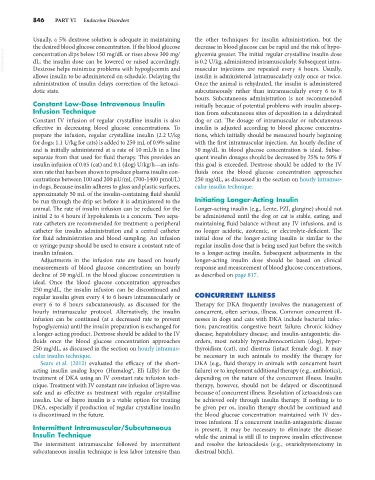Page 874 - Small Animal Internal Medicine, 6th Edition
P. 874
846 PART VI Endocrine Disorders
Usually, a 5% dextrose solution is adequate in maintaining the other techniques for insulin administration, but the
the desired blood glucose concentration. If the blood glucose decrease in blood glucose can be rapid and the risk of hypo-
VetBooks.ir concentration dips below 150 mg/dL or rises above 300 mg/ glycemia greater. The initial regular crystalline insulin dose
is 0.2 U/kg, administered intramuscularly. Subsequent intra-
dL, the insulin dose can be lowered or raised accordingly.
Dextrose helps minimize problems with hypoglycemia and
insulin is administered intramuscularly only once or twice.
allows insulin to be administered on schedule. Delaying the muscular injections are repeated every 4 hours. Usually,
administration of insulin delays correction of the ketoaci- Once the animal is rehydrated, the insulin is administered
dotic state. subcutaneously rather than intramuscularly every 6 to 8
hours. Subcutaneous administration is not recommended
Constant Low-Dose Intravenous Insulin initially because of potential problems with insulin absorp-
Infusion Technique tion from subcutaneous sites of deposition in a dehydrated
Constant IV infusion of regular crystalline insulin is also dog or cat. The dosage of intramuscular or subcutaneous
effective in decreasing blood glucose concentrations. To insulin is adjusted according to blood glucose concentra-
prepare the infusion, regular crystalline insulin (2.2 U/kg tions, which initially should be measured hourly beginning
for dogs; 1.1 U/kg for cats) is added to 250 mL of 0.9% saline with the first intramuscular injection. An hourly decline of
and is initially administered at a rate of 10 mL/h in a line 50 mg/dL in blood glucose concentration is ideal. Subse-
separate from that used for fluid therapy. This provides an quent insulin dosages should be decreased by 25% to 50% if
insulin infusion of 0.05 (cat) and 0.1 (dog) U/kg/h—an infu- this goal is exceeded. Dextrose should be added to the IV
sion rate that has been shown to produce plasma insulin con- fluids once the blood glucose concentration approaches
centrations between 100 and 200 µU/mL (700-1400 pmol/L) 250 mg/dL, as discussed in the section on hourly intramus-
in dogs. Because insulin adheres to glass and plastic surfaces, cular insulin technique.
approximately 50 mL of the insulin-containing fluid should
be run through the drip set before it is administered to the Initiating Longer-Acting Insulin
animal. The rate of insulin infusion can be reduced for the Longer-acting insulin (e.g., Lente, PZI, glargine) should not
initial 2 to 4 hours if hypokalemia is a concern. Two sepa- be administered until the dog or cat is stable, eating, and
rate catheters are recommended for treatment: a peripheral maintaining fluid balance without any IV infusions, and is
catheter for insulin administration and a central catheter no longer acidotic, azotemic, or electrolyte-deficient. The
for fluid administration and blood sampling. An infusion initial dose of the longer-acting insulin is similar to the
or syringe pump should be used to ensure a constant rate of regular insulin dose that is being used just before the switch
insulin infusion. to a longer-acting insulin. Subsequent adjustments in the
Adjustments in the infusion rate are based on hourly longer-acting insulin dose should be based on clinical
measurements of blood glucose concentration; an hourly response and measurement of blood glucose concentrations,
decline of 50 mg/dL in the blood glucose concentration is as described on page 817.
ideal. Once the blood glucose concentration approaches
250 mg/dL, the insulin infusion can be discontinued and
regular insulin given every 4 to 6 hours intramuscularly or CONCURRENT ILLNESS
every 6 to 8 hours subcutaneously, as discussed for the Therapy for DKA frequently involves the management of
hourly intramuscular protocol. Alternatively, the insulin concurrent, often serious, illness. Common concurrent ill-
infusion can be continued (at a decreased rate to prevent nesses in dogs and cats with DKA include bacterial infec-
hypoglycemia) until the insulin preparation is exchanged for tion; pancreatitis; congestive heart failure; chronic kidney
a longer-acting product. Dextrose should be added to the IV disease; hepatobiliary disease; and insulin-antagonistic dis-
fluids once the blood glucose concentration approaches orders, most notably hyperadrenocorticism (dog), hyper-
250 mg/dL, as discussed in the section on hourly intramus- thyroidism (cat), and diestrus (intact female dog). It may
cular insulin technique. be necessary in such animals to modify the therapy for
Sears et al. (2012) evaluated the efficacy of the short- DKA (e.g., fluid therapy in animals with concurrent heart
acting insulin analog lispro (Humalog®, Eli Lilly) for the failure) or to implement additional therapy (e.g., antibiotics),
treatment of DKA using an IV constant rate infusion tech- depending on the nature of the concurrent illness. Insulin
nique. Treatment with IV constant rate infusion of lispro was therapy, however, should not be delayed or discontinued
safe and as effective as treatment with regular crystalline because of concurrent illness. Resolution of ketoacidosis can
insulin. Use of lispro insulin is a viable option for treating be achieved only through insulin therapy. If nothing is to
DKA, especially if production of regular crystalline insulin be given per os, insulin therapy should be continued and
is discontinued in the future. the blood glucose concentration maintained with IV dex-
trose infusions. If a concurrent insulin-antagonistic disease
Intermittent Intramuscular/Subcutaneous is present, it may be necessary to eliminate the disease
Insulin Technique while the animal is still ill to improve insulin effectiveness
The intermittent intramuscular followed by intermittent and resolve the ketoacidosis (e.g., ovariohysterectomy in
subcutaneous insulin technique is less labor intensive than diestrual bitch).

